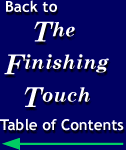

|
Issue Twenty-two, Winter 1999 |
BINDING:
Where It All Comes Together
Source: Graphic Arts Monthly (July 1981)
Very frequently, we confine our
consideration of paper requirements and problems
to the printing process, because we tend to regard printed
paper as the final product. Obviously, this is often not
true since much printed output is bound in some manner for
its ultimate use. It all comes together in the bindery. At
this final stage of assembly, problems can arise. They can
stem from binding requirements neglected during the
specifying and printing of paper, or printing requirements
that may conflict with those of the bindery or make binding
more difficult. Or, they may be problems peculiar to the
binding job itself.
Thickness
and Bulk
Basis weight and thickness relate to the maximum number of
pages that can be folded into a signature. For example, it
may be possible to fold a given 60-lb paper into 32-page
signatures, whereas a 70-lb paper will require 16-page
signature. As paper thickness is increased, it becomes
necessary to fold into signatures with fewer pages to avoid
folding problems related to thickness.
Thickness also relates to the ease or difficulty with which
a book can be opened and its pages turned. For any given
paper, its stiffness, the resistance it offers to being bent
or flexed, varies as the cube of its thickness. For example,
if its thickness is doubled, its stiffness will increase
eight times. Consequently, as thicker paper is used it
becomes more difficult to turn the pages of a bound
book.
Grain
Direction
Grain direction is always an important consideration in
the bindery. It is desirable that the first fold be made
parallel to the grain. It is a cardinal rule that the grain
direction in the pages of a book be parallel to the bound
edge or spine of the book. Grain direction perpendicular to
the spine makes pages stiffer and more difficult to turn and
lay down. Distortion and buckling of pages at the bound edge
are much more likely to occur when the grain runs
perpendicular to the binding.
Squareness
and Strength
Sheets that are out-of-square can present serious bindery
problems. Sheets originally out-of-square may not be
troublesome during printing but can cause inaccurate folding
and misalignment of printing, trimmed edges, and margins
during binding. Paper should be trimmed to squareness prior
to printing. Out-of-square sheets that originate during
press slitting likewise can be troublesome in the
bindery.
Paper must have adequate strength for applications like
gatefolds and inserting, and to resist pulling away from
staples, which leads to the detachment of magazine and
booklet covers. Also, it must withstand the cutting action
of binding threads, trim without the shattering of its edges
and the breaking out of chunks of fibers or coating, and not
block under trimming pressure.
Moisture
Other problems that arise during or after binding relate to
moisture and relative humidity. As paper loses moisture, its
fibers become less pliable. Server moisture loss, which can
occur during heat-set drying, leads to brittle paper that
may crack at the fold. If this occurs in signatures
delivered at the end of a press, it can be detected
immediately and eliminated or minimized. However, if sheets
are subsequently folded in the bindery, problems due to
severe moisture loss may not arise until binding, at which
time it is too late to go back and correct the cause of the
problem.
Wavy or tight edges that develop due to uneven moisture
regain or loss throughout the sheet area can cause wrinkling
during folding. Moisture differences and imbalance remaining
among the various signatures as they are trimmed and bound
into a book can lead to post-bindery problems. As the
various bound sheets regain moisture and individually
condition to their environment, some will grow in size more
than others. This results in page sections with stepped,
uneven edges that no longer resemble the neatly trimmed
edges of binding. Another consequence of severe moisture
readjustment is buckling at the bound edge of the book.
Adhesive
Compatibility
Adhesive binding requires that the hot-melt adhesive
penetrate into and among paper fibers to form a strong bond.
High-density, relatively nonporous papers such as coated
papers are more difficult to adhesive bind than bulky,
rough, and porous uncoated papers. Paper properties that
allow formation of bonds between paper and hot-melt
adhesives are porosity, smoothness, and receptivity to the
adhesive. Adhesion of a coated surface and a hot-melt
adhesive may relate to the chemical make-up of the coating
and the extent to which the two chemically bond to each
other.
To form a strong adhesive bond between the book body and its
cover, the backbone of a book is roughened, notched, or
patterned in some manner to increase the area for adhesion
and to give greater penetration and binding strength to the
hot-melt adhesive. If the bound cover is a coated paper, it
cannot be roughened for adhesive penetration. Anchoring of
the hot-melt adhesive to the unroughened coated surface
depends mainly upon chemical compatibility.
Consideration of bindery requirements for paper must not be
overlooked at the inception of the graphic arts product.
Communication among the bindery, printer, and paper and
other suppliers must exit to assure a most satisfactory
final product. Remember, it is the bindery that brings the
product to its final form.
About Rasch Graphics | More
Information
PUR Binding | Perfect
Binding | Saddle Stitching | Mechanical
Binding
Tab Cutting | Support
Services | The Finishing Touch Newsletter
EMail RGS | Home
Page
![]()
![]()
7211 N. Gessner Drive • Houston, TX 77040-3143
Phone: 800 / 713-785-5750 • Fax: 800 / 713-785-5801